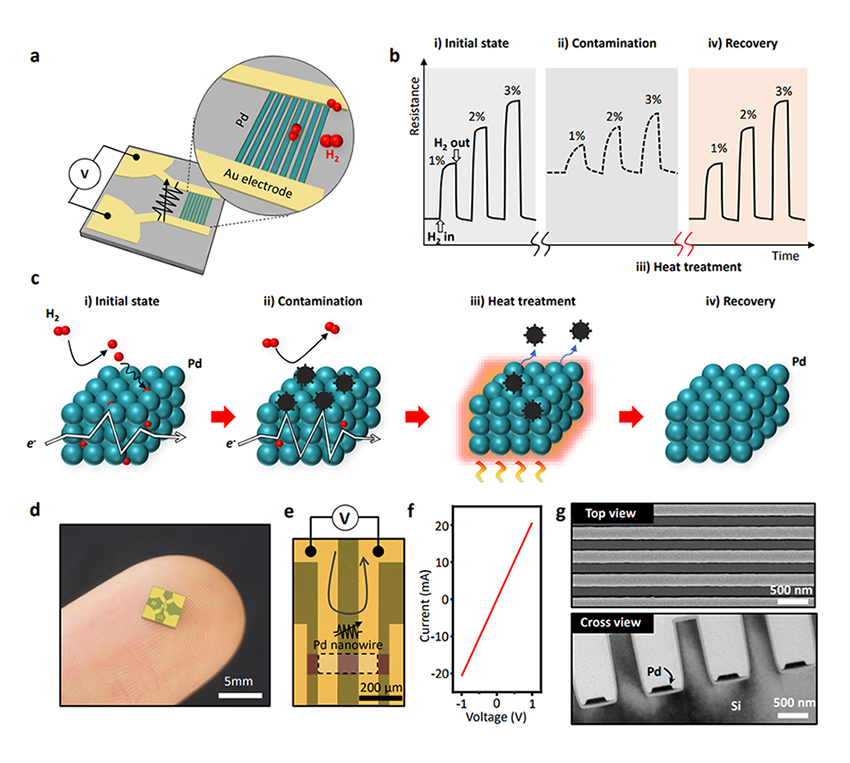의생명융합공학부 서민호 교수 연구팀이 장시간 안정적으로 수소 가스 농도를 무선으로 검출하는 고민감도 센서 기술 개발에 성공했다.
‘수소 가스’는 에너지 효율이 뛰어나고, 연소 시 오직 물만 배출하는 친환경 연료로 각광받고 있다. 그러나 무색·무취의 수소는 4% 농도 이상일 때 극도로 위험한 폭발성을 띠어 안전 관리가 필수적이다. 이를 위한 초고감도 수소 감지 센서 개발이 요구되는 상황에서 연구팀이 장시간 성능이 유지되는 팔라듐 기반의 고성능 센서를 개발해 차세대 에너지 산업 혁신이 기대된다.
은백색 금속인 팔라듐(Pd)을 이용한 기존 수소 감지 센서는 민감도가 뛰어나지만, 대기 중에 노출되면 오염돼 성능이 급격히 저하되는 한계가 있었다. 그러나 이번 연구에서는 팔라듐 표면 오염의 근본 원인을 밝히고, 이를 완벽히 제거하는 방법까지 제시했다.

【제안하는 팔라듐 수소 가스 센서 성능 회복 방법 컨셉(a~c)과 실제 제작된 팔라듐 나노와이어 수소 센서(d~g)】
연구팀은 양자역학 기반의 밀도 범함수 이론(DFT)과 실험 분석을 통해 대기 중 이산화탄소(CO₂)가 팔라듐 표면을 오염시키는 주범임을 밝혀냈고, 200℃의 열로 오염 물질을 제거해 팔라듐의 초기 성능을 완벽히 회복시키는 기술을 개발했다.
이 기술을 바탕으로 반도체 기반 마이크로기계전자시스템(MEMS)을 적용해 손톱 크기의 초고성능 팔라듐 수소 센서를 제작, 2달 이상 대기 중 방치된 후에도 열처리만으로 초기 성능을 완벽하게 되살리는 데 성공했다.
이번 연구를 주도한 서민호 교수는 “이번 성과는 수소 가스 누출 사고 예방과 수소 에너지의 안전성 강화에 획기적인 전환점을 제공하며, 수소 경제의 핵심 기술로 자리잡을 것”라고 전망했다.
해당 연구 결과는 ‘Long-term reliable wireless H₂ gas sensor via repeatable thermal refreshing of palladium nanowire(팔라듐 나노와이어의 열 회복 매커니즘을 통한 장시간 지속 가능한 무선 수소 가스 센서)’라는 제목으로 국제 학술지 『네이처 커뮤니케이션즈(Nature Communications)』온라인판 10월 9일자에 게재됐다.
- 논문 링크: https://www.nature.com/articles/s41467-024-53080-0
이번 연구는 2024년도 과학기술정보통신부와 한국연구재단의 선도연구센터지원사업, 중견연구지원사업과 혁신연구센터지원사업의 지원을 받아, 부산대 의생명융합공학부 서민호 교수팀과 나노에너지공학과 강준희 교수팀, 한국과학기술원(KAIST) 윤준보 교수 연구팀 공동으로 진행됐다.
* 상단 인물 사진: 왼쪽부터 강준희 교수와 서민호 교수
[Abstract]
The increasing significance of hydrogen (H₂) gas as a clean energy source has prompted the development of high-performance H₂ gas sensors. Palladium (Pd)-based sensors, with their advantages of selectivity, scalability, and cost-effectiveness, have shown promise in this regard. However, the long-term stability and reliability of Pd-based sensors remain a challenge. This study not only identifies the exact cause for performance degradation in palladium (Pd) nanowire H₂ sensors, but also implements and optimizes a cost-effective recovery method. The results from density functional theory (DFT) calculations and material analysis confirm the presence of C = O bonds, indicating performance degradation due to carbon dioxide (CO₂) accumulation on the Pd surface. Based on the molecular behavior calculation in high temperatures, we optimized the thermal treatment method of 200℃ for 10 minutes to remove the C = O contaminants, resulting in nearly 100% recovery of the sensor’s initial performance even after 2 months of contamination.
* Reference
- Authors (Pusan National University)
· Min-Ho Seo (School of Biomedical Convergence Engineering)
· Joonhee Kang (Department of Nanoenergy Engineering)
· Ki-Hoon Kim (Department of Information Convergence Engineering)
- Title of original paper: Long-term reliable wireless H₂ gas sensor via repeatable thermal refreshing of palladium nanowire
- Journal: Nature Communications
- DOI: https://doi.org/10.1038/s41467-024-53080-0

